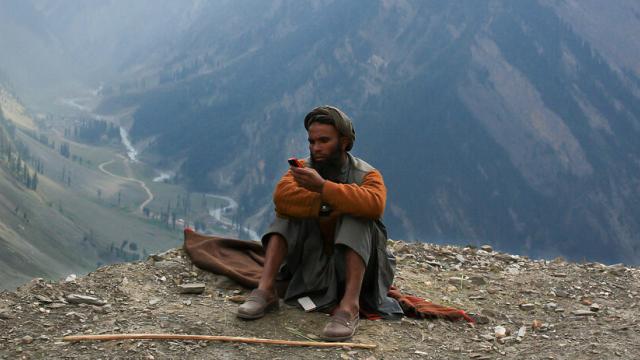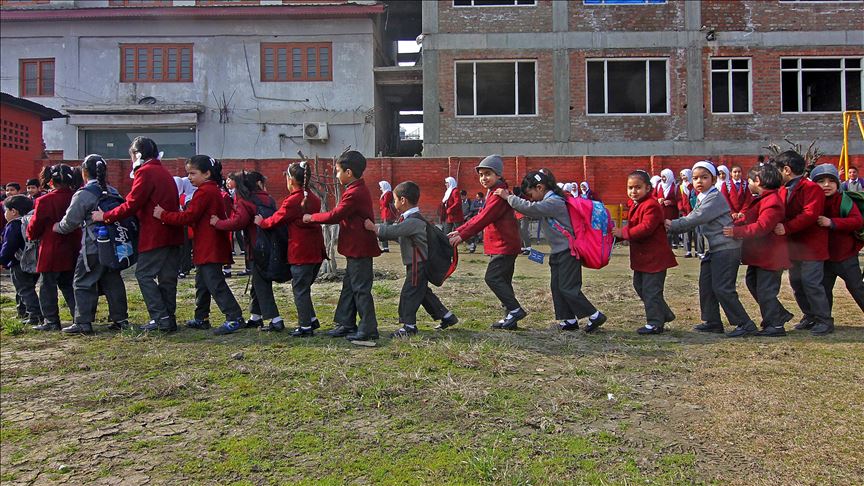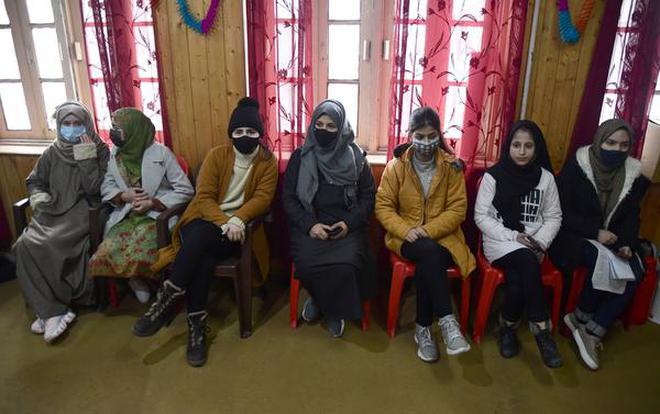
A man uses his mobile phone in the Kashmir Valley. Photo: Pracsshannt K/Flickr, CC BY 2.0
Mir Quasim, an undergraduate journalism student in Kashmir, India, has only attended a few months of classes – yet he is nearly done with his degree. Quasim is one among many students and soon-to-be-graduates in this conflict-ridden state who has little actual experience of being in college.
“We are used to this now,” Quasim said. “The government believes that shutting down schools and blocking the internet will resolve the situation, but that rarely happens.” In fact, as Quasim’s story shows, the pandemic has only exacerbated the problem of young people trying to get an education in Kashmir.
Unlike other parts of India, students in Kashmir saw schools close in August 2019, when the Indian government stripped Kashmir of its special status – including its autonomy and its ability to formulate laws for the state’s permanent residents – and brought it under the direct rule of India. The arbitrary decision, enacted without popular mandate, resulted in the blocking of phone lines and the internet in what many criticized as “digital apartheid.”
As the TIME magazine recently reported, Kashmir was just coming out of the “world’s longest lockdown” when the COVID-19 pandemic hit. The country’s National Education Policy may have recommended a focus on technology, but regular power outages remained common across the region. The Indian government often shut down internet and other communication in a dubious bid to prevent terrorist activities, though there was little to show that this was an effective step.
Kashmir was just emerging from this crisis when the pandemic struck, but this time there were no communication blackouts – just blunt educational inequality. Yet for the students of Kashmir, the pandemic allowed them to discover a sense of resilience and mutual aid as they helped each other and tried to ensure that no one was left behind.
As a researcher studying journalism and misinformation in conflict-ridden regions, my interviews with teachers and students from different universities in Kashmir revealed that during the pandemic, people came together to use whatever technology they could to help sustain education and learning in their communities.
Forms of protest lead to new solutions
As the coronavirus spread, schools and colleges were shuttered, but phones and internet were still available. Yet as classes shifted online, students in Kashmir only had access to 2G internet, whereas across the rest of the country students had easy access to high-speed 4G internet.
Students in Kashmir are used to undergoing long periods without school, which often hampers their ability to apply for higher education as well as jobs. But this time, they didn’t sit idly by. In the absence of functional technology for learning, teachers and professors reported seeing students band together to create study circles and generously share notes and recordings of classes for those who were unable to afford internet service.
In such a situation, the “best form of protest,” said Gauhar, a third-year student, “is to strengthen community ties in a way that best serves us.” The students had to deal with bad internet connectivity that often made listening in class difficult. In response, they created WhatsApp groups to share notes and audio recordings so that classmates would not fall behind.
As Dulkar, another university student said, “We were determined to make the best of the situation. We would share our computers and make recordings of classes to share with those who often did not have power to turn on computers during classes.”
Teachers, too, ensured that they supported their students by reworking class assignments and creating exams based more on essays so that students could work on their own, rather than take question-answer tests. “I usually had quizzes that I would regularly give the students,” said one professor who has been teaching for ten years.
“I encouraged students to interview their family members to understand their family history and, in the process, learn how the state has developed and coped with different problems over the years.”
Assignments were changed to help students stay close to home. Professors saw this as a chance to encourage them to collect oral histories of people in their locality. As one professor said, “I do not blame the media for covering only the raw side to Kashmir’s conflict and the usual lockdowns. But there is more to the lives of the people here. They have developed methods of coping that are unique to Kashmir.”
For the students, this was a time to learn subjects like history and economics through the voices of their immediate communities. “I never knew that my grandmother was such an Urdu poetry aficionado,” said Zareen, a history student who was about to graduate. She said her language skills had become more polished since she started regularly conversing with her grandmother and her sisters.
Hardships persist
Kashmir remains a deeply under-reported region, where the media mostly focuses on the chronic situation of war and conflict. Travelers to Kashmir are often surprised that their phones, which work in other states in India, may be completely useless due to the region’s strict telecom rules. The Kashmir dispute has been considered the “core of one of the most intractable conflicts in modern history,” and this long-term strife has deeply affected education in the state.
District Census records from the Indian government show that despite an enormous set of challenges, including terrorist attacks, Kashmir still has about 95 institutes of higher education, including 12-degree colleges for women. Kashmir may be the only state in the country with free education in government institutes, but literacy rates are still low compared with the rest of India.
Frustrated by government apathy, the International Federation of Journalists and the South Asia Media Solidarity Network launched a social media campaign to highlight Kashmir’s ongoing internet controls amid the COVID-19 pandemic, but with little effect. Universities tried to help students who didn’t have smartphones or laptops receive technical help, though the universities themselves were poorly equipped. Few institutes were able to afford paid Zoom sessions and most students had access only to a free version that allowed only 45-minute learning sessions.
At the same time, deep inequalities persist for women seeking to access even basic technology, as sexism and misogyny remain regular features of everyday life. The women I interviewed were happy that they were able to continue classes even after universities closed with the pandemic.
But attending online classes often meant sharing computers or homes with brothers and other male family members whose use of the technology was encouraged, whereas their needs mostly came second. One woman complained that her brother’s classes sometimes occurred at the same time as hers, which meant he could attend live lessons while she often had to watch poorly recorded versions of her course.
Students from remote areas like Rajouri, Rakhmuthi and Devipur villages, in the district of Jammu, were particularly impacted during the lockdown. “It was very hard for some families to suddenly bear the cost of smartphones,” said one professor.
Educators meanwhile found it hard to connect with their classes online. Nonetheless, professors said they were heartened by the efforts students have made, and the spirit of cooperation that could signal changes in the way that Kashmir is perceived from outside. Today, students have proven they are part of a generation that is hungry for knowledge, and resilient enough to work around technical barriers.
But teachers remain worried about times when the government may arbitrarily shut off the internet again.
“What then?” said one professor. “Students need basic lines [of communication], and sometimes the government just wants to cut off everything.”


















